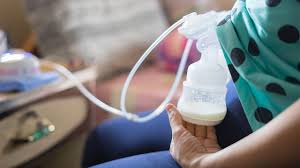Breastfeeding medically complex babies and children
Lyndsey Hookway
Paediatric Nurse, Health Visitor, IBCLC, Author, PhD researcher exploring the needs of medically complex breastfed children. Founder of Breastfeeding the Brave
@FeedSleepBond (Twitter) @lyndsey_hookway (Instagram)
Summary
This factsheet explores the challenges and research evidence associated with breastfeeding medically complex babies and children.
What we know
Breastfeeding is the biologically normal way to feed all babies.1 However, it can be challenging to establish breastfeeding even with a healthy baby. There are many more barriers that exist when a baby has an acute or chronic illness, condition, congenital anomaly or disability.2 There are practical and psychological challenges for parents, as well as difficulties relating to infant illness or the nature of the baby’s condition.
There are increased risks associated with not breastfeeding, and the immunological importance of breastfeeding may be even more vital for infants who are unwell.3,4 Therefore, parents of medically complex baby’s may need more, different, specialised or targeted support to help them achieve their breastfeeding goals.
The Baby Friendly Initiative’s standards apply within most maternity units, many neonatal units and within the community and this has had a positive impact on women choosing to breastfeed.5 However, there are no standards at the present time within paediatrics.6 This means that parents are more likely to receive timely and accurate support from maternity units, as well as the neonatal unit and health visiting teams, but less likely to receive that support in the paediatric environment, including paediatric wards, the emergency department and paediatric intensive care.
There is very little research into what the barriers and challenges are in a general sense for these women and families. The literature that exists tends to focus on specific conditions. There is a clustering of research relating to breastfeeding outcomes and challenges associated with four main types of condition. These are: conditions that affect muscle tone (such as Down syndrome), the intra-oral space and facial anatomy (such as cleft palate), increased caloric need (such as cardiac problems), and the difficulties with the composition or metabolism of milk (such as phenylketonuria).
Research themes
There are seven main themes within the available research:
- Breastfeeding outcomes may be affected by practical barriers such as transport to hospital from home7, hospital accommodation8, logistical challenges of caring for other children and needing to maintain milk supply and modify breastfeeding because of a baby’s medical complexity.9,10
- Breastfeeding can be more challenging to maintain because of psychological barriers for women. For example, studies have found that parents experience a higher frequency of stress, anxiety, frustration, depression and grief.11,12
- For some babies and children, their illness is severe or critical, and they are too unwell or unstable to breastfeed. For example, babies in paediatric intensive care unit or cardiac critical care may be receiving mechanical ventilation or be recovering from surgery.8,10,13
- Some babies are medically stable, but the nature of their condition makes breastfeeding more difficult – such as when they have a palate abnormality, problems with low tone, or cannot metabolise fats or amino acids so requiring modification of breastmilk or partial breastmilk feeding.9,10,12,14
- It is often difficult to access specialised lactation support in the paediatric setting. There is often no designated support service, unlike the maternity and neonatal unit, and parents may struggle to access support that is available in the community if they are resident with their baby or child in hospital.15,16
- Paediatric health care professionals do not necessarily receive adequate training in breastfeeding management and there is certainly no standardised training program.17,18
- To maintain lactation when an baby cannot be breastfed directly, equipment is needed – such as breast pumps, specilaised feeding devices, tubes, and speciliased breastfeeding techniques may need to be taught to women to facilitate the return to breastfeeding. Parents also need to be shown how to optimally use a pump, and how to select and use certain equipment.19,20
While it is clear that there are many barriers and challenges associated with maintaining breastfeeding for a medically complex baby or child, it is also evident that many parents do successfully continue to breastfeed their children.
What we don’t know
There is currently limited information relating to the unique needs and challenges of breastfeeding sick babies. No studies have explored the impact of childhood illness or medical complexity in a general sense. This is important, because the information generated is not necessarily generalisable, but also because most paediatric wards admit babies and children with a range of diseases and illnesses, both acute and chronic.
It is perhaps more useful and user-friendly for health professionals who may not have specific expertise in infant feeding to have general guidelines for best practice when supporting breastfed children and families in the paediatric setting, rather than expecting medical and nursing staff to search for and access numerous disease-specific protocols.
There is also almost no data about how the hospital experience affects the duration and exclusivity of breastfeeding, outside of the disease-specific examples already mentioned.
The majority of children under four years admitted to hospital have an infectious illness21 and half of the total hospital days are accounted for by children with a complex medical condition.22 The challenges of being admitted to hospital apply to both parents and children and are in addition to general breastfeeding challenges.
The success of breastfeeding may depend on numerous factors, including parental motivation prior to hospitalisation, whether breastfeeding was going well before, the degree of exclusivity, timely access to support and information, and early initiation of breastfeeding, among many others.23
The quality, small sample sizes, time span and global variation reported in the research available limits the ability to form solid conclusions, and future research should rigorously explore barriers in a more general sense.
It is unclear what difference socio-economic status, ethnic background, parental motivation and prenatal preparation has on breastfeeding outcome due to limited data at the present time.
Mothers and families: how to use the evidence
- If you receive a diagnosis of a congenital anomaly before baby is born, research sources of support in advance. Find a certified breastfeeding counselor who is experienced at supporting medically complex children and make a plan for how to optimise breastfeeding
- Join the ‘Breastfeeding the Brave’ Facebook group, administrated by an International Board-Certified Lactation Consultant and paediatrician for peer support, and information
- Consider donating milk – some parents have reported that this gave them another reason to keep going
- Seek out other breastfeeding parents – either on the ward, or online, for friendship, practical tips, and support
- Ask for a breast pump proactively – it can sometimes take time to source one
- Identify an advocate who can champion your breastfeeding goals and encourage you in your journey
Midwives and birth workers: how to use the evidence
- Consider expanding your current breastfeeding education offering to staff in the paediatric department
- Peer supporters could visit parents on the paediatric ward to provide support and information
- Invest in breast pumps dedicated to the paediatric department, so that pumps do not need to be borrowed from maternity and neonatal units, which can cause delays
- Familiarise yourselves with the peri-operative fasting guidelines
- Create formal liaison pathways between the infant feeding coordinator located in the maternity unit and the charge nurse in paediatric wards, paediatric emergency departments and paediatric intensive care department
Links to other resources
 Film Audio
Film Audio
Breastfeeding the Brave video
 Guidelines
Guidelines
World Breastfeeding Trends Initiative: World Breastfeeding Trends Initiative. (2020). State of Maternity Protection in 97 Countries: An analysis of WBTi country reports.
The WHO code of marketing of breastmilk substitutes: World Health Organization. (1981). International code of marketing of breast-milk substitutes. Available at:
Academy of Breastfeeding Medicine protocols are available on a variety of conditions
 Social Media
Social Media
Breastfeeding the Brave Facebook
 Websites
Websites
UK Association of Milk Banking
Hearts Milk Bank – for support with milk banking, sourcing donor milk, or fat separating breastmilk for use with infants with chylothorax
References
- Victora, C. G., Bahl, R., Barros, A. J., França, G. V., Horton, S., Krasevec, J., … & Group, T. L. B. S. (2016). Breastfeeding in the 21st century: epidemiology, mechanisms, and lifelong effect. The Lancet, 387(10017), 475-490.
- Coates, M. M., & Riordan, J. (1992). Breastfeeding during maternal or infant illness. NAACOG’s clinical issues in perinatal and women’s health nursing, 3(4), 683-694.
- Edwards, T. M., & Spatz, D. L. (2010). An innovative model for achieving breast-feeding success in infants with complex surgical anomalies. The Journal of perinatal & neonatal nursing, 24(3), 246-253.
- Thomas, V. (2019). Breastfeeding sick babies. In Brown, A., Jones, W.. A Guide To Supporting Breastfeeding For The Medical Professional. Routledge, Abingdon.
- Fallon
- Carney, G., & Bruce, D. (2011). Is It Time for “Baby-Friendly” Pediatric Hospitals?. ICAN: Infant, Child, & Adolescent Nutrition, 3(4), 190-192.
- Rendón-Macı́as, M. E., Castañeda-Muciño, G., Cruz, J. J., Mejı́a-Aranguré, J. M., & Villası́s-Keever, M. A. (2002). Breastfeeding among patients with congenital malformations. Archives of medical research, 33(3), 269-275.
- Heilbronner, C., Roy, E., Hadchouel, A., Jebali, S., Smii, S., Masson, A., … & Rigourd, V. (2017). Breastfeeding disruption during hospitalisation for bronchiolitis in children: a telephone survey. BMJ paediatrics open, 1(1).
- Banta-Wright, S. A., Kodadek, S. M., Houck, G. M., Steiner, R. D., & Knafl, K. A. (2015). Commitment to Breastfeeding in the Context of Phenylketonuria. Journal of Obstetric, Gynecologic & Neonatal Nursing, 44(6), 726-736.
- Barros da Silva, R., Barbieri-Figueiredo, M. D. C., & Van Riper, M. (2019). Breastfeeding experiences of mothers of children with down syndrome. Comprehensive child and adolescent nursing, 42(4), 250-264.
- Lewis, E., & Kritzinger, A. (2004). Parental experiences of feeding problems in their infants with Down syndrome. Down Syndrome Research and Practice, 9(2), 45-52.
- Madhoun, L. L., Crerand, C. E., Keim, S., & Baylis, A. L. (2019). Breast Milk Feeding Practices and Barriers and Supports Experienced by Mother–Infant Dyads With Cleft Lip and/or Palate. The Cleft Palate-Craniofacial Journal, 1055665619878972.
- Barbas, K. H., & Kelleher, D. K. (2004). Breastfeeding success among infants with congenital heart disease. Pediatric nursing, 30(4).
- Moe, J. K., Holland, M. D., & Johnson, R. K. (1998). Breastfeeding practices of infants with Rubinstein-Taybi syndrome. Journal of Human Lactation, 14(4), 311-315.
- Ryan, K., Smith, L., & Alexander, J. (2013). When baby’s chronic illness and disability interfere with breastfeeding: Women’s emotional adjustment. Midwifery, 29(7), 794-800.
- Lambert, J. M., & Watters, N. E. (1998). Breastfeeding the infant/child with a cardiac defect: an informal survey. Journal of Human Lactation, 14(2), 151-155.
- Gupta, A., Suri, S., Dadhich, J. P., Trejos, M., & Nalubanga, B. (2019). The world breastfeeding trends initiative: Implementation of the global strategy for infant and young child feeding in 84 countries. Journal of public health policy, 40(1), 35-65.
- Gavine, A., MacGillivray, S., Renfrew, M. J., Siebelt, L., Haggi, H., & McFadden, A. (2016). Education and training of healthcare staff in the knowledge, attitudes and skills needed to work effectively with breastfeeding women: a systematic review. International breastfeeding journal, 12(1), 6.
- Meier, P. P., Patel, A. L., Hoban, R., & Engstrom, J. L. (2016). Which breast pump for which mother: an evidence-based approach to individualizing breast pump technology. Journal of Perinatology, 36(7), 493-499.
- Boyce, J. O., Reilly, S., Skeat, J., Cahir, P., & Academy of Breastfeeding Medicine. (2019). ABM Clinical Protocol# 17: Guidelines for Breastfeeding Infants with Cleft Lip, Cleft Palate, or Cleft Lip and Palate—Revised 2019. Breastfeeding Medicine, 14(7), 437-444.
- Gill, P. J., Goldacre, M. J., Mant, D., Heneghan, C., Thomson, A., Seagroatt, V., & Harnden, A. (2013). Increase in emergency admissions to hospital for children aged under 15 in England, 1999–2010: national database analysis. Archives of disease in childhood, 98(5), 328-334.
- Gold, J. M., Hall, M., Shah, S. S., Thomson, J., Subramony, A., Mahant, S., … & Hametz, P. (2016). Long length of hospital stay in children with medical complexity. Journal of hospital medicine, 11(11), 750-756.
- Brown, A. (2018). What do women lose if they are prevented from meeting their breastfeeding goals?. Clinical Lactation, 9(4), 200-207.









